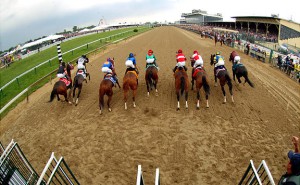Post Positions Play a Role in Handicapping
in Educational Articles, General Discussion, Handicapping, Horse Racing, WinningPonies.com | 8 Comments >>
 Post position statistics become a more important component of handicapping when races are staged at certain distances. Naturally, the most significant aspect of the data is the ratio of victories.
Post position statistics become a more important component of handicapping when races are staged at certain distances. Naturally, the most significant aspect of the data is the ratio of victories.
The general bias against outside posts is particularly strong at foremost North American ovals, especially in routes such as a mile on Aqueduct’s inner track and Santa Anita, 1 1/16 miles at Hollywood Park and 1 1/8 miles at Aqueduct.
These tracks commonly card routes that start near the beginning of the clubhouse turn. Consequently, stats at most meetings show that horses breaking from the inside four posts on the dirt or synthetic surfaces win more than their fair share of starts while runners starting from post 8 and outward capture far fewer races.
For example, horses that drew post seven and outward Nov. 4-20 for Aqueduct routes on the dirt were 3 for 20, with the three winners coming out of No. 8, while sprinters breaking from 8 and outward were 7 for 24.
Runners breaking from post 7 and outward Nov. 10-20 over Hollywood Park’s Cushion surface at a mile or longer were zero for 9 while sprinters were 10 for 24.
Some tracks such as Gulfstream Park tailor their races to limit the short run to the first turn, giving outside horses an even chance to make the winner’s circle.
Gulfstream, which opens a month earlier this year on Dec. 3, lengthened its main track to 1 1/8 miles in 2005, with the backstretch chute allowing sprints up to 7 ½ furlongs.
If you want to benefit from the post position bias, get acquainted with the layout of the tracks you play. Pay attention to the distance of two-turn races that begin near the clubhouse turn – an inherent disadvantage for outside runners.
Posts usually are less of a factor in sprints because there’s sufficient distance along the backstretch to get in stride and racing position.
In six-horse fields, however, the bias disappears because any thoroughbred coming out of the gate should find position with ease.
In addition, post position bias is less important when the runners are classier, the stakes are bigger and the contest is on the grass.
Look for these ideal-betting angles when a horse moves from the outside to an inside post:
- A runner showing improvement and hitting the board tosses in a dull effort breaking from an impossible post last time out. The switch to the inside might put the horse back in the winner’s circle.
- A thoroughbred normally does well pressing the pace, but started poorly in his last race from the outside and finished out of the money. A favorable draw will dramatically affect the horse’s racing position early and improve the chances to score.
- A horse that was competitive in similar races that routed from an outside post near the clubhouse turn and failed to hit the board will improve with a better draw. The shorter the two-turn race, the more it favors the inside.
Extra emphasis should be given to horses customarily racing on or near the lead. Less emphasis should be given to stretch runners that figure to be outrun early no matter their post.

